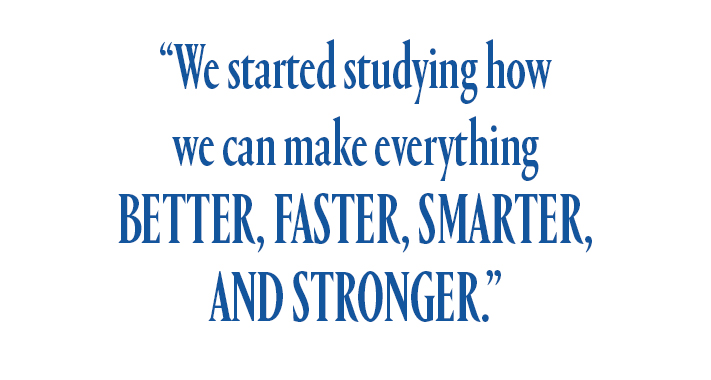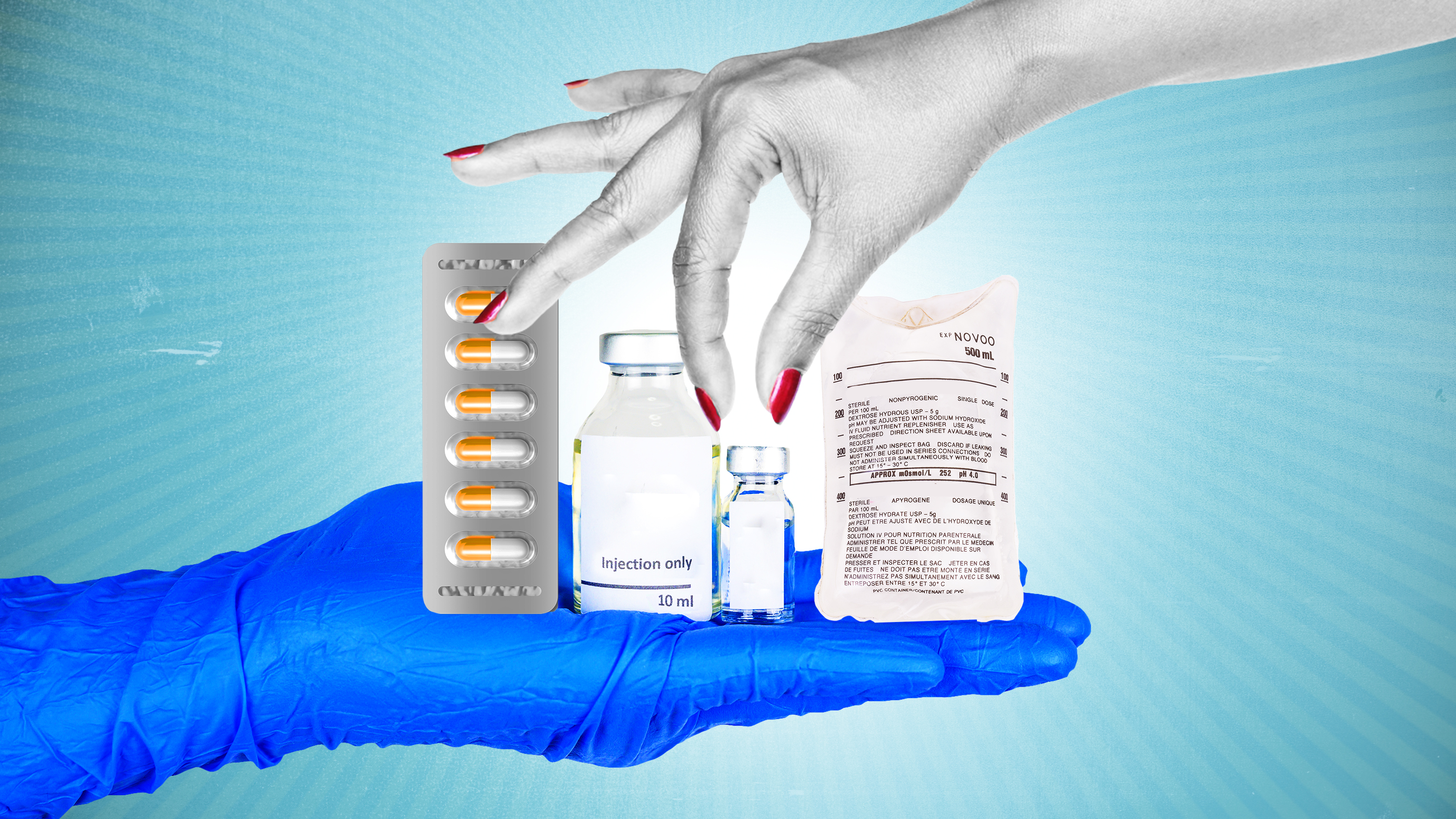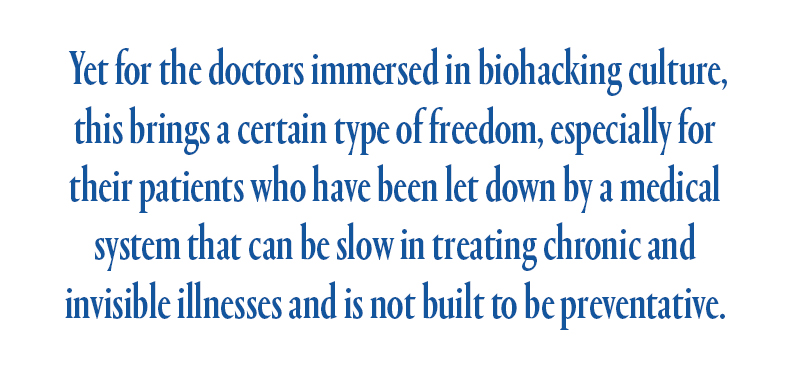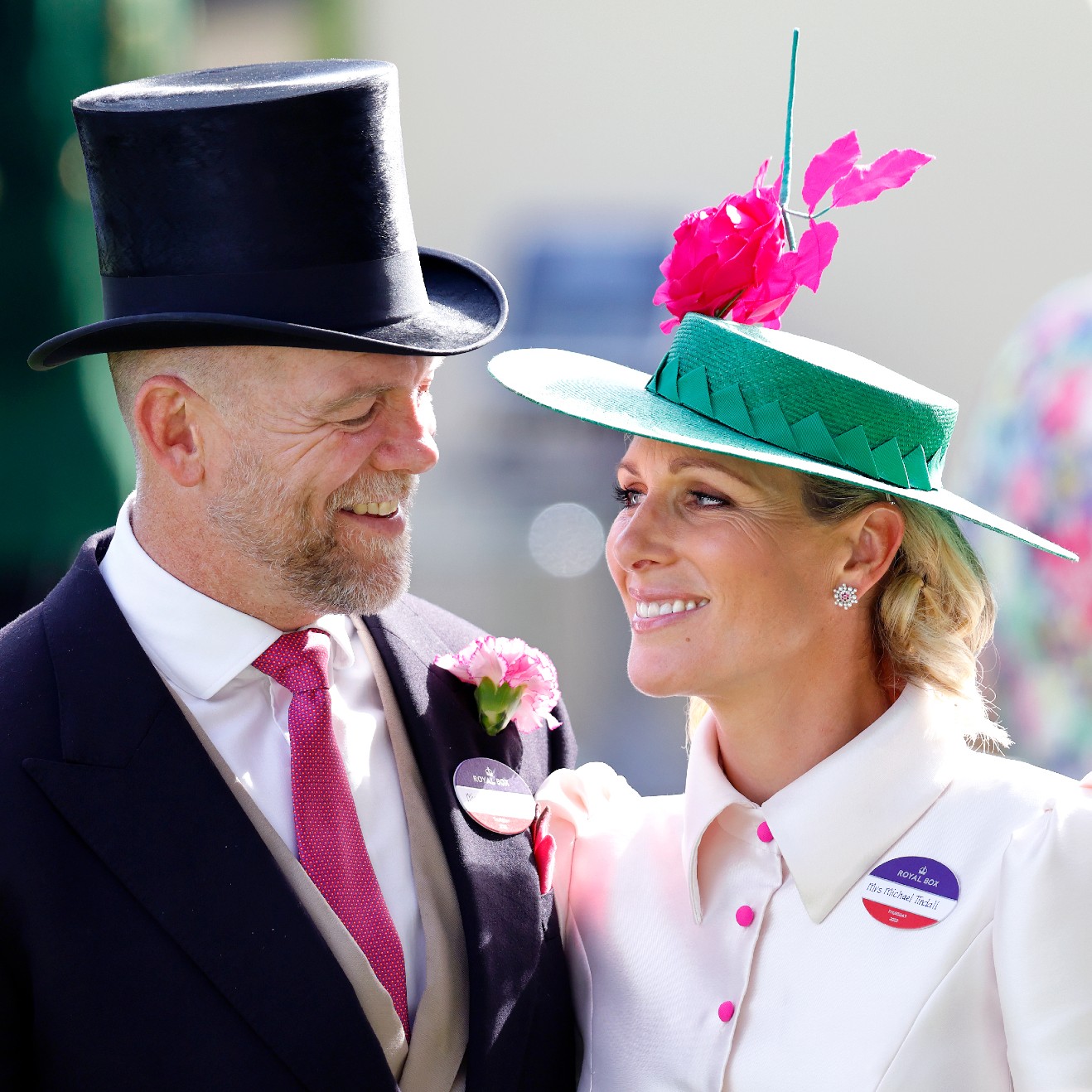Inside the World of Ambitious Aging
Where some say you can make your body and mind feel, look, and function decades younger.


On paper, Grace Adele is in her biological prime. The 27-year-old health enthusiast lives an active lifestyle and eats wholesome meals. She looks healthy. Ask her how she feels, though, and you get a different story. Adele has skin issues and gut problems, residual body pain from past injuries, and discomfort related to scoliosis. Her ailments left her desperate to find a way to elevate her health—for her insides to match her outside. A novel concept in a world obsessed with Internet Face.

“I did extensive research, explored every health craze, gut-healing protocol, and skincare regimen within reach,” she says. Her search led her to an “anti-aging and longevity center” in New York called Hudson Health, a clinic that rejects the one-size-fits-all nature of reactive medicine and embraces internal anti-aging. There, under the guidance of board-certified anesthesiologist and pain medicine specialist Dr. Jonathann Kuo, Adele enrolled in a program that claims to reset the nervous system and improve mental clarity. She had IV vitamin drips to boost her immune system, decrease inflammation, and support brain health; she received peptide injections to improve digestion, sleep, and combat aging. It might sound woo-woo to outsiders, but for Adele it was transformative. “I’ve had extraordinary results,” she says. “From my general wellbeing to pain management and mental health—everything has seen a significant improvement.”
Adele isn’t alone in her search for internal optimization. The idea that our anti-aging toolkit is limited to superficial procedures and products is being turned on its head—or rather, inside-out—thanks to a niche group of highly specialized (albeit experimental) medical professionals, who are on a mission to anti-age everyone’s insides.
Human optimization. Regenerative medicine. Metabolic aesthetics. Biohacking. Many terms for essentially the same thing: when preventative medicine and functional medicine collide and people try to change their personal biology in an effort to improve their health. “We look at you as an individual and assess your hormonal and vitamin deficiencies. We see what makes you gain weight, makes you fatigued, or decreases your libido,” explains Yana Delkhah, M.D., a board-certified emergency medicine physician who helped launch SKINNEY Wellness, a functional medicine and biohacking hub.
The baseline belief of biohacking is that you don’t have to succumb to the common pitfalls of aging, like experiencing brain fog or joint pain. And while the space is vast and a little unwieldy—there is little long-term research or government-stamped clinical trials; every “expert” has their own opinion, menu of treatments, and best practices—it’s undoubtedly on the rise. The $20 billion biohacking industry is projected to increase nearly 19 percent annually in the next decade.

“Biohacking really emerged about 10 years ago in response to the optimization culture of Silicon Valley,” says Molly Maloof, M.D., a biohacking-focused physician, Stanford lecturer, and author of The Spark Factor. “We started studying how we can make everything better, faster, smarter, and stronger.”
Do-it-yourself biohacking can be easy, so effortless that you might be practicing it without realizing it. If you’ve incorporated a sauna blanket, meditation, or red light therapy into your daily routine to de-stress—that’s biohacking. If you’ve optimized your sleep cycle by going to bed in a cool room with blackout shades and taken proper vitamins to boost your energy—that’s biohacking. If you’ve followed a keto diet to try and resolve a health issue—that’s biohacking, too. But biohacking can also be extreme. Like trying to edit your own DNA. Each option follows one driving principle: Do humans really have to age like we have in the past?
Stay In The Know
Get exclusive access to fashion and beauty trends, hot-off-the-press celebrity news, and more.
No, says David Shafer, M.D., who opened Advitam, a medical clinic in New York City that is pushing the boundaries of anti-aging treatments through a combination of hormone replacement therapy, peptide optimization, IV therapy, and platelet-rich plasma therapy (PRP). “It’s aesthetics in a general sense, but on a metabolic level,” says Dr. Shafer. “Yes, it’ll make you look better on the outside, but it’s also weight loss, energy, sexual drive, performance enhancement—it all goes together.”
A very popular internal anti-aging trick offered at Advitam is peptide therapy. More than 7,000 peptides occur naturally in the human body. In recent years, they’ve been synthetically recreated to be used in a clinical setting, orally, topically, or by injection to enhance bodily functions. For example, certain peptides can keep memory acute and brain fog at bay. Another peptide, named BPC-157, has “excellent gastrointestinal healing properties,” according to Jamie Gabel, a board-certified physician assistant at Advitam who focuses on metabolic medicine.

Of course, the most mainstream peptide is GLP-1. You know it as Ozempic. The FDA-approved diabetes medication is now being used off-label for weight loss management—notably in Hollywood and by those with the financial circumstances to hand over more than $900 for a month’s supply. The drug, while not FDA-approved for non-diabetic patients and controversial in nature, has served as an appetite suppressant with the ability to aid individuals in achieving a thinner version of themselves.
Depending on who you visit, treatment options abound. Vitamin drips, which can be a powerful supplemental instrument, are highly popular, widely accepted, and low-risk. For example B-12, which is “your biggest energy booster for losing weight, having energy, and not having brain fog,” according to Dr. Delkhah, can work wonders for patients. You can take a B-12 pill, sure. But get it dripped into your bloodstream and you’ll have more intense results in a fraction of the time.
There are also PRP treatments, which involve injecting your own plasma into your skin to spark collagen production or scalp to stimulate hair growth. Some clinics even offer stem cell therapy to repair damaged tissue or hormone replacement therapy to increase sexual drive or get women through hot flashes associated with menopause. Some of these treatments have been around for years. Others are new and have little to no scientific studies to back them.
That people are being given agency over their health is good. But it’s not all great. These treatments don’t come cheap. A consultation can range from $250 to $800. Vitamin drips like biotin cost around $50 per week. Other vitamin drip infusions have $250 or $350 price tags. Peptides, which might need to be done weekly or monthly, can be thousands of dollars. Insurance companies rarely get involved (at least for now) and depending on the combination of therapies, you could be looking at tens of thousands of dollars every few months. It raises the question of who has the right to feel good and healthy and vibrant.

Even if you have the money, internal optimization efforts are not without risk. Many treatments are understudied. “It's not necessarily always safe. It depends on the person and the situation,” says Amy Killen, M.D., a leading regenerative medicine physician and founder of the Human Optimization Project. “Getting in a sauna or eating certain types of food are proven to be safer. But stem cells are still considered experimental. A lot of your peptides are still considered experimental—and most of them are not FDA-approved.” Even when the treatments aren’t necessarily new, the way they’re being prescribed to patients is outside the confines of the standard medical system. See above: Ozempic.
Or take Hormone Replacement Therapy (HRT), which seeks to balance hormonal changes. Its goal is to re-optimize depleting levels of estrogen, testosterone, and progesterone that come with age, while alleviating “vaginal dryness or discomfort, hot flashes, decreased sex drive, and brain fog” along with the increased risk for “osteoporosis, weight gain, or memory loss,” says Gabel. It is also sometimes used to help with fertility. The treatment is typically given under the supervision of a gynecologist, but because the end goal is to adjust the body’s natural aging process, biohacking doctors, who have backgrounds and board certifications ranging from emergency medicine to plastic surgery, are absorbing it into their care. And some are administering bio-identical estrogen, progesterone, and testosterone through a pellet inserted underneath the skin, called hormone pellet therapy. Lucky Sekhon, M.D., a board-certified reproductive endocrinologist, infertility specialist, obstetrician, and gynecologist at RMA of New York, believes that hormone pellet therapy is dangerous territory. Without rigorous tests and clinical trials, she says it is the equivalent of the “wild, wild west.”
Some extreme biohacking ventures have even been met with FDA resistance. Bryan Johnson, a tech centimillionaire in pursuit of eternal life, recently did a three-way multi-generational blood transfusion with his 19-year-old son and 70-year-old father in the name of rejuvenation. The practice is popular in more radical biohacking circles—and has historically been met with FDA warnings. “There is no proven clinical benefit of infusion of plasma from young donors to cure, mitigate, treat, or prevent these conditions, and there are risks associated with the use of any plasma product,” former FDA Commissioner Scott Gottlieb wrote.

Medical institutions are rightfully skeptical of biohacking’s non-traditional aspects. It’s a fast-paced industry that largely skips over lengthy approval processes. Yet for the doctors immersed in biohacking culture, this brings a certain type of freedom, especially for their patients who have been let down by a medical system that can be slow in treating chronic and invisible illnesses and is not built to be preventative. “In traditional medicine, doctors don’t have the time to sit down with you for an hour and talk about emotional, mental, physical, and environmental factors affecting your health. That’s the benefit of these cash-pay hubs. [Biohacking] doctors do have the time to sit down with you for an hour every few months and create a very personalized program,” says Dr. Killen. “But doctors are just there to act as a guide. That's what's exciting about this field of biohacking and optimization—we're actually empowering the consumer to take care of their own health.”
Adds Dr. Delkhah: “As an M.D., our job is to treat a disease. When we’re in med school we learn a billion diseases, learn how to diagnose them, treat them, and save lives. But there’s this whole other aspect that we don’t take into play.” The goal is not the fountain of youth. The goal, she says, is to “make the time you do have the best quality humanly possible.” "Biohacking” isn’t anti-medicine, it’s just a new kind of medical care for those ambitious enough to pursue it.

Samantha Holender is the Senior Beauty Editor at Marie Claire, where she reports on the best new launches, dives into the science behind skincare, and shares the breakdown on the latest and greatest trends in the beauty space. She's studied up on every ingredient you'll find on INCI list and is constantly in search of the world's glowiest makeup products. She's constantly tracking the biggest nail and hair trends to pop up in the beauty space, going backstage during fashion weeks, tracking celebrity looks, and constantly talking to celebrity hair stylists, nail artists, and makeup artists. Prior to joining the team, she worked as Us Weekly’s Beauty and Style Editor, where she stayed on the pulse of pop culture and broke down celebrity beauty routines, hair transformations, and red carpet looks. Her words have also appeared on Popsugar, Makeup.com, Skincare.com, Delish.com, and Philadelphia Wedding. Samantha also serves as a board member for the American Society of Magazine Editors (ASME). She first joined the organization in 2018, when she worked as an editorial intern at Food Network Magazine and Pioneer Woman Magazine. Samantha has a degree in Journalism and Mass Communications from The George Washington University’s School of Media and Public Affairs. While at GWU, she was a founding member of the school’s HerCampus chapter and served as its President for four years. When she’s not deep in the beauty closet or swatching eyeshadows, you can find her obsessing over Real Housewives and all things Bravo. Keep up with her on Instagram @samholender.
-
 Princess Anne's Unexpected Suggestion About Mike Tindall's Nose
Princess Anne's Unexpected Suggestion About Mike Tindall's Nose"Princess Anne asked me if I'd have the surgery."
By Amy Mackelden Published
-
 Queen Elizabeth's "Disapproving" Royal Wedding Comment
Queen Elizabeth's "Disapproving" Royal Wedding CommentShe reportedly had lots of nice things to say, too.
By Amy Mackelden Published
-
 Palace Employees "Tried" to Get King Charles to "Slow Down"
Palace Employees "Tried" to Get King Charles to "Slow Down""Now he wants to do more and more and more. That's the problem."
By Amy Mackelden Published